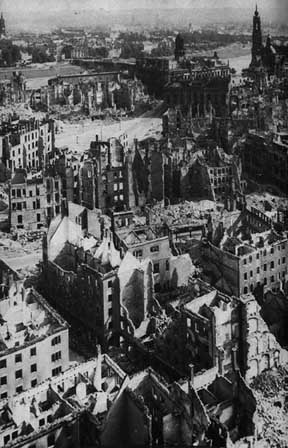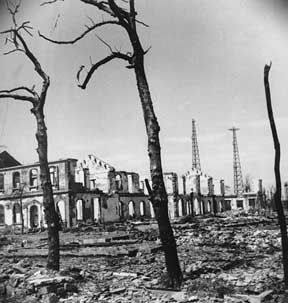
May 2003
U.S./British Massacre at Dresden

Right: Center of
Dresden after bombing by U.S. and British planes on 13-14 February 1945.
(Photo: AP)
Mussolini’s use of terror bombing in Ethiopia was inspired by the doctrines of Italian general Giulio Douhet, whose 1921 treatise, The Command of the Air, became the bible for the “strategic bombing” plans of all the imperialists, fascist and “democratic” alike. While such horrific plans could be tried out against Kurdish and Ethiopian peasant soldiers in hills and mountains, their ultimate target is the population of large urban concentrations, and the proletariat in particular. In 1920, at a time when many European rulers shook in fear of workers revolution “at home,” the chief of the British Air Staff, Sir Hugh Trenchard, wrote in a paper that the Royal Air Force could even suppress “industrial disturbances or risings” in England itself (David Omissi, “Baghdad and British Bombers,” Guardian [London], 19 January 1991). Churchill told Trenchard not to refer to this proposal again, but 20 years later, during the second imperialist world war, both the “Axis” and the “Allies” put Douhet’s plans into practice.
Hitler was notorious for sending his Luftwaffe (air force) to annihilate Rotterdam, Holland in May 1940, killing 30,000 people in an effort to bomb the Dutch population into submission; for his bombing of the English cathedral town of Coventry later that year, which killed 500 in a single ten-hour raid; and for the London Blitz, lasting from September 1940 to May 1941, in which over 20,000 civilians were killed. The German military developed this into the doctrine of “Schrecklichkeit” (frightfulness), which was defined by Chris Cook’s Dictionary of Historical Terms (1983) as the “deliberate policy of committing atrocities to subdue a subject people.” This Nazi policy was the direct antecedent of the Pentagon’s air war doctrine, “Shock and Awe,” which was precisely intended to terrorize the Iraqi population into submission.
But even in World War II, the German fascist dictator was rivaled on this score by the imperialist Allies, both the British and the Americans, who between them slaughtered an estimated 635,000 German civilians with their terror bombing. R.H.S. Crossman (a right-wing social democrat and later cabinet minister, then in charge of psychological warfare against Germany for the Foreign Office) reports that in the early years of WWII there was a debate in the British government over the use of bombers against the German population. Fearing heavy casualties from a European landing, Prime Minister Churchill was willingly persuaded by the Air Marshalls that priority should be given not to opening a Second Front on the continent but to building bombers to pound German cities until the population had been, as Crossman put it, “systematically ‘de-housed’ and pulverized into surrender.”
The bombing was deliberately aimed at the terrorizing the German proletariat. A February 1942 directive to the Bomber Command contained the following Valentine's Day message: “You are accordingly authorized to employ your forces without restriction . . . (operations) should now be focused on the moral of the enemy civil population and in particular, of the industrial workers.” Placed in charge of the command that carried out the raids was none other than “Bomber Harris,” who got his start indiscriminately killing Iraqis.
The “democratic” British leader had no compunction about deliberately targeting the civilian population: “Now everyone's at it,” Churchill was quoted as saying. “It's simply a question of fashion - similar to that of whether short or long dresses are in” (quoted in Mickey Z., “From Dresden to Baghdad: 58 Years of ‘Shock and Awe’,” On-Line Journal, 13 February). By July 1943, Harris had perfected the technique of firebombing to the point that the Allies were able to create a firestorm in Hamburg, killing 50,000 civilians. The bombers deliberately targeted densely populated areas rather than industrial or transportation districts; incendiary and high-explosive bombs were dropped, the latter in order to destroy metallic roofs. By concentrating fire in an area they could create an inferno, causing huge numbers of casualties not only from burns, but also from smoke inhalation, carbon monoxide poisoning and asphyxiation, as the oxygen is sucked out by the conflagration. This was not accidental, but deliberate mass murder.
Toward the end of 1944, the Allies caused firestorms in more than half a dozen German cities, culminating in the firebombing of Dresden on 13-14 February 1945, perhaps the largest single massacre in history. The purpose was not to hit military or industrial objectives – there were few such targets in the area, no munitions plants, the rail yards were not hit – but to cause maximum casualties in order to intimidate the Soviets, whose army crossed the Oder River at the end of January headed for Berlin. An internal RAF memo said that Dresden was jammed full of “refugees pouring westwards…. The intentions of the attack are to hit the enemy where he will feel it most...and to show the Russians when they arrive what Bomber Command can do.” Air Marshall Harris designed the Dresden raid to first create a firestorm and then spread it with subsequent attacks to kill the survivors. Thousands of individual fires came together, whipping up huge winds and superheated air. Crossman writes:
“The fire storm transformed thousands of individual blazes into a sea of flames, ripping off the roofs, tossing trees, cars and lorries into the air, and simultaneously sucking the oxygen out of the air-raid shelters.
”Most of those who remained below ground were to die painlessly, their bodies first brilliantly tinted bright orange and blue, and then, as the heat grew intense, either totally incinerated or melted into a thick liquid sometimes three or four feet deep.”
–R.H.S. Crossman, “Apocalypse at Dresden,” Esquire, November 1963Mickey Z. has an equally grisly account:
“Seventy percent of the Dresden dead either suffocated or died from poison gases that turned their bodies green and red. The intense heat melted some bodies into the pavement like bubblegum, or shrunk them into three-foot long charred carcasses. Clean-up crews wore rubber boots to wade through the ‘human soup’ found in nearby caves. In other cases, the superheated air propelled victims skyward only to come down in tiny pieces as far as fifteen miles outside Dresden.”After the first wave of British bombers came a second wave three hours later, designed to spread the fire to the huge open area of the royal park and to the great square in front of the railway station – places where thousands of survivors had fled – and to hit every one of the 19 hospitals in the city. Then, as the survivors (many of them crippled) were gathering their meager strength the next morning a third wave of bombers and fighters hit the city. This time the USAF which strafed the royal park and the roads out of town, deliberately machine-gunning the defenseless crowds of refugees.
How many were killed? The figure of 225,000 was widely circulated; Crossman estimates upwards of 150,000. Fascist “historians” like David Irving have long pointed to the Dresden massacre in order to relativize the Nazi Holocaust of the Jewish people and to absolve the Nazi regime of its horrendous crimes. Yet the Dresden massacre was one of the most horrific war crimes in history, and one carried out by the “democratic” imperialists. For his services rendered to the British Empire, “Bomber” Harris later received a Knights Grand Cross from the Queen (as well as a Legion of Merit from the U.S.).

Left: Tokyo after
bombing by U.S. in March 1945. The incendiary bombs, a mixture of thermite
and oxydizing agents sometimes including napalm, burned 200 km2
of the Japanese capital, killing more than 100,000 people. (Photo:
Dave Davis/AP)
When news concerning the bombing of Dresden got out, it led to an uproar that had to be quieted by cynical denials that this was U.S. or British policy. But it was, and it continued, now against Japan. In March 1945, more than 100,000 Japanese were killed in a firebombing raid on Tokyo as “canals boiled, metal melted, and buildings and human beings burst spontaneously into flames” (John Dower, War Without Mercy: Race & Power in the Pacific War [Pantheon Books, 1986]). By August 1945, 58 Japanese cities had been firebombed and the bomber commander, General Curtis LeMay, had to curtail his raids because he had run out of incendiary bombs. After the war, Le May remarked “I suppose if I had lost the war, I would have been tried as a war criminal.” Instead he was promoted, eventually heading the Strategic Air Command, where he advocated a pre-emptive nuclear “first strike” against the Soviets. During the Vietnam War, Le May notoriously called to “bomb them [the North Vietnamese] back into the Stone Age.”
The firebombing of Japanese cities culminated in the atomic bombing of Hiroshima on 6 August 1945 and Nagasaki three days later, slaughtering more than 200,000 Japanese. The purpose was not to “hasten the end of the war,” as was claimed, for secret negotiations for Japanese surrender were already underway when the bombs were dropped. As in Dresden, these were not military targets: the horrendous death toll of the civilian population was the intended purpose of the raids. And as at Dresden, the key purpose of the A-bombing of Japan was to serve as a warning to the Soviet Union (which following the Red Army’s victory over Nazi Germany had just turned its forces against Japan) of the lengths to which bloodthirsty U.S. imperialism would go to annihilate its enemies. And indeed, in the subsequent wars against North Korea and Vietnam during the half-century long anti-Soviet Cold War, American armies and their puppet forces slaughtered some six million Koreans and Vietnamese. n
To contact the Internationalist Group and the League for the Fourth International, send e-mail to: internationalistgroup@msn.com